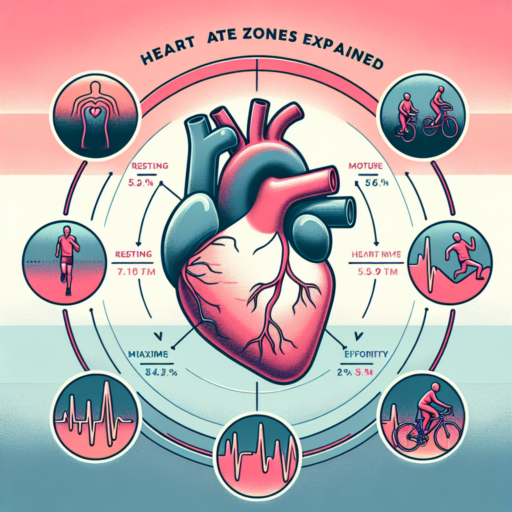No se han encontrado productos.
Introduction to Zone 3 Training: Benefits for Your Fitness Routine
Embracing the concepts of heart rate zones can revolutionize the way you approach your fitness routine, with Zone 3 training standing out as a particularly beneficial intensity level for many athletes. Traditionally, this zone is characterized by a moderate to vigorous intensity level that significantly improves cardiovascular and metabolic efficiency. Integrating Zone 3 workouts into your regime can be a game-changer for both your endurance and your overall performance.
One of the key benefits of Zone 3 training is its ability to enhance aerobic capacity. This is the zone where you’re working hard enough to challenge your cardiovascular system, yet not so hard that you can’t sustain the activity for an extended period. It’s the sweet spot for improving your body’s ability to transport and use oxygen during prolonged periods of exercise, which is essential for longer races or workouts. Moreover, training in this zone can also lead to better fat utilization as a fuel source, contributing to more efficient energy use and improved body composition over time.
Focusing on Zone 3 also allows athletes to build a strong foundation for their fitness. It’s characterized by a heart rate that’s roughly 70-80% of your maximum, making it manageable yet challenging. Regularly training in this heart rate zone can help in increasing lactate threshold, which means you’ll be able to perform at higher intensities before lactic acid begins to accumulate and fatigue sets in. This paves the way for improved performance in both high-intensity bursts and endurance events.
What is Zone 3 Training and How Does it Work?
Zone 3 Training refers to a specific intensity level within structured workout programs, especially prevalent in cardiovascular exercises such as running, cycling, and swimming. This zone is characterized by a moderate to vigorous intensity that challenges the aerobic system, enhancing cardiovascular fitness and endurance. The concept of training zones, including Zone 3, is derived from the understanding of heart rate zones, which are used to guide training intensity for optimal performance improvements and fitness development.
Functionally, Zone 3 Training operates by targeting a heart rate range of approximately 70% to 80% of an individual’s maximum heart rate. This intensity level is significant for improving aerobic capacity without overstraining the body, which is crucial for endurance athletes and fitness enthusiasts looking to increase their stamina over time. Training in this zone helps in efficiently burning calories, improving blood circulation, and increasing the body’s ability to utilize oxygen during prolonged physical activity.
The effectiveness of Zone 3 Training hinges on its ability to strike a balance between intensity and volume. Proper utilization of this training zone involves careful monitoring of one’s heart rate to remain within the target range, thereby ensuring that each workout is conducted at an optimum intensity for aerobic improvement. By regularly engaging in exercises within Zone 3, individuals can progressively enhance their fitness levels, ultimately leading to better performance in endurance sports and activities.
The Science Behind Zone 3 Training: Understanding the Physiological Effects
Zone 3 training, often referred to as the «tempo» zone, plays a crucial role in an athlete’s endurance and performance by challenging the body in a unique way. This intensity level, which is typically achieved at 70-80% of an athlete’s maximum heart rate, is particularly effective for improving cardiovascular fitness and increasing metabolic efficiency. The physiological effects of training in this zone are both profound and beneficial, contributing significantly to an athlete’s ability to sustain higher intensities over longer durations.
Enhanced Cardiovascular Efficiency
The consistent practice within Zone 3 leads to enhanced cardiovascular efficiency. This improvement is largely due to an increase in stroke volume, which is the amount of blood the heart pumps with each beat. Over time, the heart becomes more efficient, reducing the heart rate at both rest and during exercise. This adaptation allows athletes to perform longer without fatigue, a direct result of the body’s improved ability to deliver oxygen to working muscles.
Increased Metabolic Efficiency
Another key physiological effect of Zone 3 training is the increase in metabolic efficiency. Training at this intensity encourages the body to utilize fat as a primary fuel source, preserving glycogen stores for more intense efforts. This shift not only aids in endurance performance but also contributes to better fuel management during prolonged activities. The ability to tap into fat stores effectively can significantly extend an athlete’s endurance capacity and delay the onset of fatigue.
Furthermore, Zone 3 training promotes the development of slow-twitch muscle fibers, which are indispensable for endurance athletes. These fibers are highly efficient at using oxygen to generate more fuel for continuous, extended muscle contractions over a long time, enhancing overall endurance and performance.
Comparing Training Zones: Is Zone 3 Training Better for Your Health?
When it comes to optimizing health and fitness, understanding the effects of varying training zones is crucial. Specifically, Zone 3 training, which typically consists of exercising at a moderate to high intensity, has been a topic of considerable debate. This zone represents a balanced challenge to the body, stimulating cardiovascular improvement while still being manageable for prolonged periods. However, the question remains: is Zone 3 training inherently better for your health compared to other zones?
In discussing the benefits of Zone 3, it’s important to first define what this means in the context of heart rate training. Zone 3 is often characterized by reaching 70-80% of your maximum heart rate, a level that significantly improves aerobic capacity and endurance. This enhancement in aerobic function can contribute to increased calorie burn, improved heart health, and better overall endurance. Yet, it’s crucial to consider the individual’s fitness level and goals, as this significantly affects whether Zone 3 training is the most beneficial approach.
Comparatively, training in Zones 1 and 2 involves lower intensity efforts that primarily focus on fat burning and foundational stamina building, respectively. While these zones play a critical role in building an endurance base, they might not offer the same cardiovascular challenges and improvements seen in Zone 3. On the other hand, Zone 4 and 5 training involves very high to maximum effort, focusing on improving speed and power. While beneficial for advanced athletes and those focusing on high-intensity interval training (HIIT), the intense nature of these zones may not be suitable for everyone, especially for those new to exercise or with specific health concerns.
How to Incorporate Zone 3 Training into Your Workout Schedule
Integrating Zone 3 training into your fitness regime is crucial for those looking to enhance their cardiovascular health and endurance. Zone 3, often termed as the ‘tempo zone’, pushes your body to work at a moderate intensity level, where speaking becomes challenging, yet manageable. This level of training targets a specific heart rate range, encouraging efficiency in your body’s ability to pump blood and oxygen.
Begin by identifying your personal Zone 3 heart rate range, which is typically between 70% to 80% of your maximum heart rate. Use a heart rate monitor during workouts to ensure you’re training within this specific range. Incorporating Zone 3 workouts into your schedule doesn’t require daily commitment; even two to three times per week can yield significant benefits. Start with shorter durations, like 20 to 30-minute sessions, and gradually increase as your endurance improves.
Strategies for Zone 3 Training
- Start Slow: Begin with a warm-up in Zone 1 or 2, gradually increasing your heart rate to enter Zone 3 with ease.
- Steady-State Workouts: Engage in steady-state exercises like cycling, swimming, or running at a consistent pace to maintain your heart rate in Zone 3.
- Vary Your Workouts: Mix up your training with different cardiovascular activities to prevent boredom and promote overall fitness.
Adapting your workout schedule to include Zone 3 training can significantly improve your cardiovascular fitness and endurance. By following these guidelines, you’ll be able to effectively integrate Zone 3 workouts into your routine, leading to better health and performance.
Pros and Cons of Zone 3 Training: Is It Right for You?
When embarking on a fitness journey, the question of which training zone to devote your time and energy to can often feel daunting. Zone 3 training is a popular topic of discussion among athletes and fitness enthusiasts alike. This intensity level, often referred to as the ‘tempo training’ zone, balances between moderate and high intensity, pushing the limits of aerobic exercise without crossing into anaerobic territory.
Benefits of Zone 3 Training
- Improved Cardiovascular Efficiency: Regular training in this zone enhances your heart’s ability to pump blood and increases your muscles’ ability to utilize oxygen, thereby improving overall cardiovascular fitness.
- Increased Fat Burning: While it’s not the primary fat-burning zone, Zone 3 workouts elevate your heart rate into a range that still encourages the body to use fat as fuel, alongside glycogen.
- Better Endurance and Performance: Athletes find that incorporating Zone 3 workouts into their regime builds endurance and helps in sustaining higher speeds for longer periods, making it an essential part of training for long-distance events.
Downsides of Zone 3 Training
- Increased Risk of Overtraining: The demanding nature of Zone 3 can lead to overtraining if not balanced with adequate rest and recovery, potentially hindering progress and leading to fatigue.
- May Neglect Other Fitness Components: Focusing heavily on Zone 3 can lead to neglect of lower intensity, recovery-based workouts or high-intensity interval training, both of which are crucial for a well-rounded fitness profile.
- Not Always the Most Efficient for Fat Loss: If your primary goal is fat loss, solely focusing on Zone 3 may not be as efficient as integrating a variety of training zones that promote higher fat oxidation rates.
Understanding the balance and how to incorporate Zone 3 training into a comprehensive fitness plan is crucial. It offers numerous benefits to cardiovascular health and endurance but should be approached with caution to avoid the pitfalls of overtraining and imbalance in your exercise regimen.
Maximizing Your Results: Tips and Strategies for Effective Zone 3 Training
When it comes to enhancing athletic performance and maximizing fitness gains, Zone 3 training holds a pivotal role. This intensity level, often described as the «comfortably hard» zone, can bridge the gap between moderate effort and high-intensity workouts. It is precisely in this sweet spot that athletes can improve their aerobic endurance and stamina without overreaching and risking overtraining.
Understanding the Fundamentals of Zone 3 Training
Zone 3 training targets a specific heart rate range, usually 70-80% of an athlete’s maximum heart rate, which stimulates both the aerobic and anaerobic systems. At this intensity, you’re working hard enough to challenge your body, but not so hard that recovery becomes extensively demanding. It’s a delicate balance that, when maintained, can lead to significant improvements in performance. Incorporating regular Zone 3 sessions into your training regimen can enhance your lactate threshold, meaning you will be able to sustain higher intensities for longer periods without fatigue.
Implementing Zone 3 Workouts Effectively
Starting with shorter durations and gradually increasing the length of time spent in Zone 3 is essential for adapting to the demands of this training intensity. Begin with sessions lasting 10 to 20 minutes and gradually increase to longer periods as your endurance builds. Utilizing tools such as heart rate monitors or smart watches can provide real-time feedback, ensuring you’re training within the correct zone. Additionally, incorporating variety into your Zone 3 workouts, through cycling, running, or rowing, for example, can prevent boredom and enhance overall enjoyment and motivation.
To truly maximize the results from Zone 3 training, it’s also important to pair this exercise intensity with complementary training zones. Sprinkling in Zone 2 (moderate intensity) and Zone 4 (high intensity) sessions throughout your weekly schedule can create a well-rounded regimen that tackles all aspects of fitness, from endurance to power. This strategic approach to training allows for adequate recovery, reduces the risk of injury, and leads to steady, sustainable progress.
Zone 3 Training Success Stories: Real-Life Transformations and Testimonials
Discover real-life transformations and testimonials from fitness enthusiasts who have taken their physical and mental well-being to the next level through Zone 3 training. This high-intensity interval training (HIIT) method is not only about pushing your limits but also about discovering your true potential both inside and out. Below, we share some of the most inspiring success stories from individuals who embarked on their Zone 3 training journey.
One remarkable tale comes from Jenny, a 35-year-old mother of two, who found a new lease on life after incorporating Zone 3 workouts into her routine. «Before Zone 3, I was struggling to find a workout that fit into my hectic lifestyle and gave me the results I desired,» Jenny reflects. Post-engagement, she noticed significant improvements in her stamina, energy levels, and overall body composition. Jenny’s story is a testament to how Zone 3 training can be seamlessly integrated into daily life, leading to profound, sustainable changes.
Another case that stands out is Michael, a former collegiate athlete who had lost sight of his fitness goals post-graduation. Zone 3 training rekindled his passion for exercise, helping him rediscover the joy in challenging his limits. «Zone 3 not only revitalized my physical fitness but also boosted my mental resilience,» says Michael. This echoes the experiences of many who find that the psychological benefits of Zone 3 training are just as valuable as the physical ones.
These stories are just the beginning. Through dedication, perseverance, and the right guidance, Zone 3 training has the power to transform lives. Whether you’re seeking to enhance your fitness level, find a community of like-minded individuals, or simply challenge yourself in new ways, the testimonials of those who’ve succeeded can serve as both inspiration and a blueprint for your journey.
Common Mistakes to Avoid in Zone 3 Training
Engaging in Zone 3 training, which targets the moderate-intensity exercise zone, is a critical step for endurance athletes looking to enhance their performance. However, common pitfalls can hinder the progress and effectiveness of these workouts. By highlighting these errors, individuals can ensure they are maximizing their training efficiency.
Overrelying on High-Intensity Workouts
One widespread mistake is the overemphasis on high-intensity workouts at the expense of Zone 3 sessions. Athletes often misconceive that harder efforts equate to better results. This misconception can lead to a neglect of Zone 3 training, which is essential for building a robust aerobic base, improving efficiency at a moderate pace, and ensuring a well-rounded conditioning.
Ignoring Recovery Time
Another crucial error is underestimating the importance of recovery. Incorporating Zone 3 workouts into your routine demands adequate rest and recovery periods to allow the body to heal and adapt. Overlooking this can result in fatigue, increased injury risk, and potentially hampering overall performance gains rather than contributing to them.
Incorrect Zone Identification
Lastly, misidentifying one’s personal Zone 3 can substantially detract from the benefits of this training strategy. Many athletes fail to conduct proper assessments to establish their Zone 3 accurately, relying instead on generic benchmarks that might not reflect their unique fitness levels. This mistake can lead to training at an inappropriate intensity, either too low to yield benefits or too high, leading to unnecessary strain and suboptimal training outcomes.
Concluding Thoughts: Should You Add Zone 3 Training to Your Fitness Regimen?
Deciding whether to incorporate Zone 3 training into your fitness regimen is not merely about chasing the latest fitness trend. It’s about understanding the intense effort Zone 3 training demands and measuring it against your fitness goals, current level, and overall health. This training zone, often referred to as the «tempo» zone, is where you exercise at a moderate to vigorous intensity—it is challenging yet sustainable for longer durations compared to higher zones. Here, the benefits unfold in the form of enhanced aerobic capacity and an improved ability to maintain high-intensity effort for an extended period.
However, before integrating Zone 3 training into your workout routine, consider your physical readiness. This middle-zone training is demanding and requires a solid foundation of fitness. If you are relatively new to regular exercise or are returning after a significant break, gradually building your fitness level through lower zones may be advisable before stepping into the more intense Zone 3. For those with a well-established fitness base, Zone 3 training can be a powerful tool to push your limits and achieve new milestones in strength and endurance.
Remember, while Zone 3 training offers substantial benefits, balance is key. Incorporating a variety of training zones into your regimen not only prevents the boredom of monotonous workout routines but also reduces the risk of overtraining and injury. It’s about listening to your body and fine-tuning your workouts to align with your goals, capabilities, and wellness journey. Hence, adding Zone 3 training can be highly rewarding, provided it is tailored to your individual needs and fitness level.




